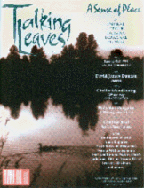

Laughter and voices reach us from the river, where most of the village has gathered to escape the oppressive midday heat. I notice the tools and seeds abandoned on the outskirts of the women's garden. Next door, a man continues his work in the plant nursery, where tiny seedlings are protected by the shade of a thatched roof. There is a boy in the pond outside the nursery, fishing from a traditional Amazonian dugout canoe. He lunges from the canoe into the brown water with a thin spear. The pond where he practices, the nursery, and the garden are part of the village's Permaculture project.
A group of foreign botanists and Permaculture activists joined with a local organization to create Permaculture America Latino (PAL), to introduce ideas of Permaculture and agroforestry to the Shipibo Indians of San Francisco. PAL and the others recognize the Shipibo people's ongoing struggle to make sense of a modern world that forces them to settle, but offers nothing to help them survive while the natural world they have always relied on disappears around them.
The difficulties faced by the people of San Francisco are shared by other Indian villages in the area. The Shipibo in their dugout canoes, fishing with spears and poles, cannot compete with the fishermen, who set nets, to feed the nearby city of Pucalpa. Furthermore, the growing population of the area has led to the destruction of a forest that once provided the Shipibo with wild fruit, nuts, barks, roots, herbs, and plants to supplement their fish-based diet. The forests have been cut down to make room for cattle or transformed into fields of yucca, plantain, and maize. PAL and the others hope that a project to promote a sustainable life will succeed among people whose grandparents remember when the river and the forest provided everything necessary in life.
San Francisco lies on the bank of Yarinacocha, an immense oxbow lake formed by the Ucayali river, a tributary of the Amazon. The village is accessible by an hour's ride in a motorized canoe from Puerto Caillo, Peru. I arrived in Puerto Caillo and paid half a Sole (about 25 cents) to the man with the brightest canoe. We traveled toward San Francisco in the fading blue dusk. Glimpses of pink skinned dolphins disappeared as quickly as apparitions. I glanced at the far shore, and the fading silhouette of a not so distant past; for I was unaware of the destruction that lay just beyond the tree lined shore. I saw only the thin shadow of a tall forest of trees giving life to dense vines and gigantic bromeliads. I didn't recognize the reality beyond the vale of wildness that manages to persevere on the edge of the cement metropolis of Pucalpa, the last outpost into the Peruvian Amazon.
I tell the old Medicine man about the image I observed on my trip out. He speaks about how quickly his people's world has changed. The rubber industry built the first roads into Peru's Amazon not more than 70 years ago, foreign oil companies paved them, and the encroaching masses followed with the dream of a better life. San Francisco is one of several small Shipibo villages that, like the image of the forest, manage to hold to the roots of their past and survive along the shore of Yarinacocha.
Iwatch a Shipibo woman and her husband walk along the giant pond toward home. He has a pole across his shoulders with two piranha dangling from either side. He flashes a toothless smile as he tells an animated story to his wife. He's had a lucky day. Many days this time of year he comes back empty handed. Even a successful day provides slim pickings for the twelve hungry mouths of the extended family they provide for.
The woman has returned from two days in Puerto Caillo, where she sells her beaded necklaces and other crafts to tourists. The first day she sold nothing and could not afford the boat fare home. This is part of the struggle that PAL and the others witnessed when they arrived in San Francisco: the challenge of daily survival in an area where what is needed has disappeared, and where the modern solutions that are presented hold little appeal. PAL recognizes, in the Shipibo of San Francisco, an incredible fortitude that transcends their grim situation. They do not wish to trade their traditions, art, and spirits for the dream of the modern world. This gives the project encouragement when difficulties arise.
PAL's history of success in South American Permaculture and agroforestry grows from their ability to work well with the local people. PAL arrived in San Francisco with the realization that to succeed they would have to find some common ground on which to sow the seeds of their ideas with the Shipibo. The creation of a pond for aquaculture was the first step, and the village's interest was piqued.
The Shipibo depend on fish as their principal source of protein. The old Medicine man tells me stories of the plentitudes of fish that once existed in Yarinacocha, when every time a Shipibo spear was sent into the obscure brown waters they emerged with food. Today, in the dry season Yarinacocha is completely cut off from the Ucayali, and the fish stocks dwindle. The fish supply of Yarinacocha is of constant concern. The stocked aquaculture of the project's pond promises to provided a backup in the dry season when Yarinacocha's stocks dwindle. The large pond is home to species of fish not necessarily prevalent in the vast waters of Yarinacocha. It provides variety in consumable fish as well as an opportunity to create additional income from baitfish. Research reveals that even swampy stagnate ponds yield 1,000 pounds of protein per acre per year if appropriate species are incorporated. The pond's aquaculture also includes the plethora of beneficial plants and herbs that flourish in the swampy vicinity of the pond, as well as water plants such as Euryhale Ferox, which produce edible seeds.
I take a walk around the pond one day with a young man from the village. Other than his American brand of shorts, he wears nothing but some beaded necklaces around his neck. Traditional strands of seeds seem to fit alongside the bright glass beads from the city. We trudge through thick underbrush; he carries a machete and wields it now and again to clear me a path. Lines of leafcutter ants march beside us. Several varieties of ripening bananas hang around us, as well as mangoes, and other tree fruit. My friend casually begins to point out important plants. It seems that almost every plant has some use. The aquaculture project is proving a simple means of self sustainability to the village.
PAL has also created a plant nursery to propagate seeds. The project depends on knowledge from tribal elders and healers about traditional plants, herbs, and medicines used by native cultures in the upper Amazon.
The seeds are collected, and cuttings taken from areas of virgin forests 20 miles down river. The plant nursery also includes a variety of fruit trees, soil enhancing species, and legumes to incorporate into the agroforestry plot.
The plants and trees started in the nursery eventually are interplanted among stands of mature trees growing outside the village. This experiment in agroforestry supplements the surrounding forest with edible and medicinal plants that were lost with the original forest. The plots also incorporate staple cultivable crops such as plantain, cassava, yucca, yams, and maize. In the tropics where 80-90% of available nutrients are retained in the biomass of the existing plants, rather than in the soil, the key to successful agriculture is to create and maintain decent humus. This is where the soil enhancing trees fit in, fixing nitrogen and creating rich compost from the leaf matter. The improved soil provides a decent base on which to experiment with various aspects of Permaculture and companion planting. The agroforestry site in San Francisco demonstrates how tropical agriculture can succeed without using the traditional destructive methods of slash and burn.
In the tropics things happen fast. One agroforestry plot planted a year ago on the outskirts of the village is a productive ecosystem in itself. As I walk along the overgrown pathways I have to watch my steps closely so as not to step on the maturing squash and pumpkins hiding within the plants, vines, and herbs. The agroforestry plots mimic the holistic system of a healthy forest. Nothing is wasted, everything has a purpose in the design. All organic matter that drops to the ground in turn provides necessary nutrients for what grows beneath, and plants complement one another by providing shade, natural insect control, or nutritional supplements. The agroforestry plots demonstrate that agriculture can exist in the Amazon without destroying the forest.
As the sun drops, the dirt streets begin to show signs of life. Erlinda and several other women gather near the Mandala garden they are creating. They laugh, catching up on the latest news. They are dressed in bright shirts and elaborately embroidered skirts. Beaded strands hang around their waists. Trade beads and bright synthetic cloth have replaced the seed beads and plant fibers of old, but the women still retain a common Shipibo identity.
The women of San Francisco are most receptive to the Permaculture project. The Shipibo are a matriarchal society, so their support is a great asset to the project's survival. The Mandala garden gives the women a means of direct involvement in the project, as well as providing a communal place to gather fruit: tomatoes, chilies, amaranth, onions, and herbs for their families. The garden is fashioned after a design in Bill Mollison's Permaculture Design Manual. In the center and in the outer circle there are trees of papaya and banana. In the inner beds they are experimenting with the companion planting of various vegetables and herbs. The women notice us across the way and shyly giggle and wave.
I smile in the direction of my companion. Together we have observed a day in the life of his people through very different eyes. His eyes are gray, sightless, knowing. Mine are young, idealistic, inquisitive. He tells me he lost his sight gradually as his people lost their world. I ask him what he thinks of the project that has taken root in his village. He tells me that lately the laughter has grown louder, he senses an emerging hope. He asks me to visit the culture center the young people have built. There they play traditional music over a battery powered boom box, accompanied by their hand made drums. They practice the dances of their ancestors, and learn about the deep traditions of their people's art and culture. It is evident in their enthusiasm that the Shipibo culture will not be another culture lost to the modern world.
The project that has taken root in San Francisco is helping to provide the village with a means of sustaining themselves, which ultimately will allow them to preserve a culture that refuses to die with the forests. The Shipibo are people of the Amazon, and like the forest they are part of, they adapt to survive. With my first image of the forest's silhouette I became aware of its perseverance. The Shipibo of San Francisco have the opportunity to emerge from beyond the thin silhouette of the forest, and take control of an uncertain future.
Suzy Loeffler has spent the last few years working on Permaculture projects throughout North, Central, and South America. She spent four months in Peru, living and working with the Shipibo of San Francisco.
�1999 Talking Leaves
Summer/Fall 1999
Volume 9, Number 2
A Sense of Place
We welcome your letters!
For a sample copy of the Summer/Fall 1999 issue, "A Sense of Place," send $6 to
